
Posts Tagged: Amy Toth
Wasp Love: Pollinators, Artists and Biocontrol Experts
What a delight to see that European paper wasp nest tucked beneath the overhang of a fence in a Vacaville, Calif. neighborhood. My first thought was "Wow! Haven't seen a Polistes dominula nest for years!" (The last one I saw was hanging out on the lip of a trash can in a UC...
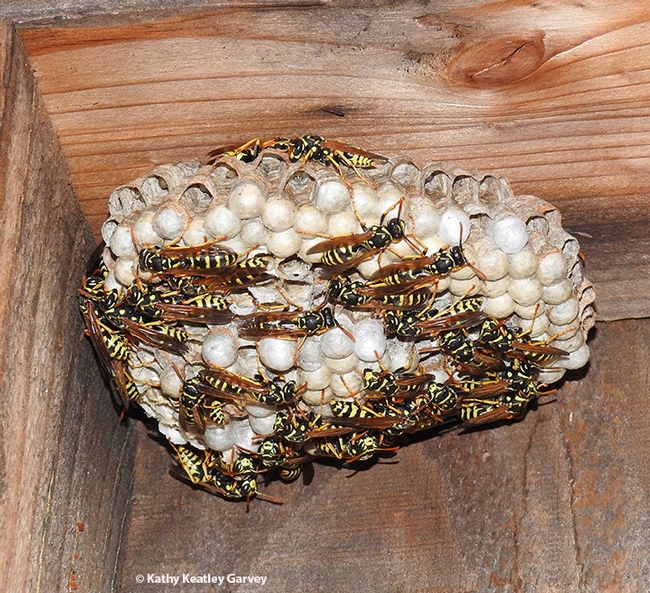
An European paper wasp (Polistes dominula) nest in Vacaville, Calif. (Photo by Kathy Keatley Garvey)
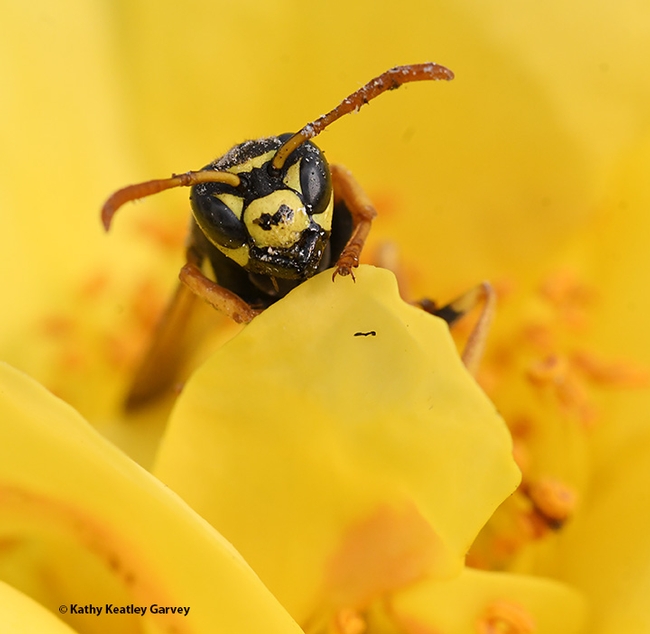
A European paper wasp, Polistes dominula, peers between the petals of a yellow rose. (Photo by Kathy Keatley Garvey)
Do You Know Where Your Pollinators Are?
It's National Pollinator Week. Do you know where your pollinators are? If you're thinking bees, butterflies, beetles, birds (hummingbirds) and bats, you're correct. But what about European paper wasps (Polistes dominula)? They're pollinators, too, says associate professor Amy Toth of the...
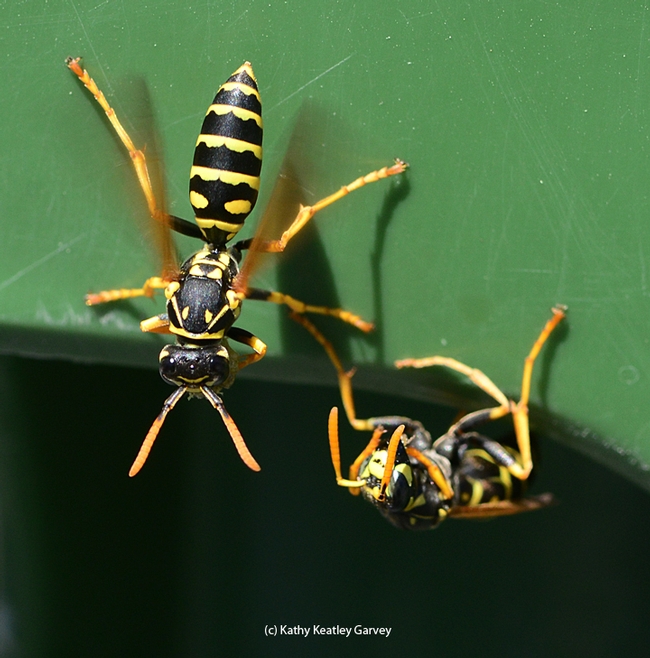
European paper wasps protecting the nest they're building on the lip of a recycling bin near the Mann lab, UC Davis campus. (Photo by Kathy Keatley Garvey)
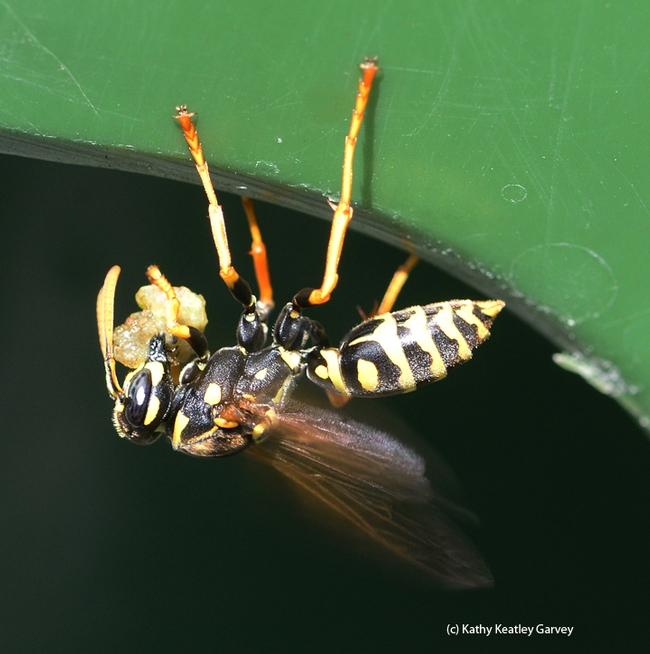
European paper wasp chowing down on food on the lip of a recycling bin near the Mann lab, UC Davis campus. Another wasp delivered it to the guard. Maybe it's the remains of a caterpillar? (Photo by Kathy Keatley Garvey)
These European Paper Wasps Didn't Get the Memo
They didn't get the memo. A sign on a recycling bin near the Mann Laboratory at the University of California, Davis, clearly reads "Bottles and Cans Only." It says nothing about wasps. But there they were: European paper wasps (Polistes dominula) building a nest yesterday beneath the overhanging...
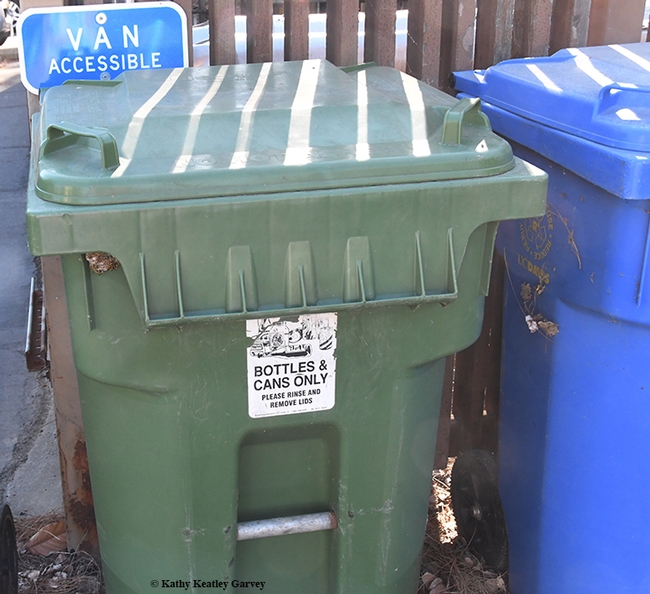
A sign on a UC Davis recycling bin clearly says "Bottles and Cans Only." It says nothing about wasps. (Photo by Kathy Keatley Garvey)
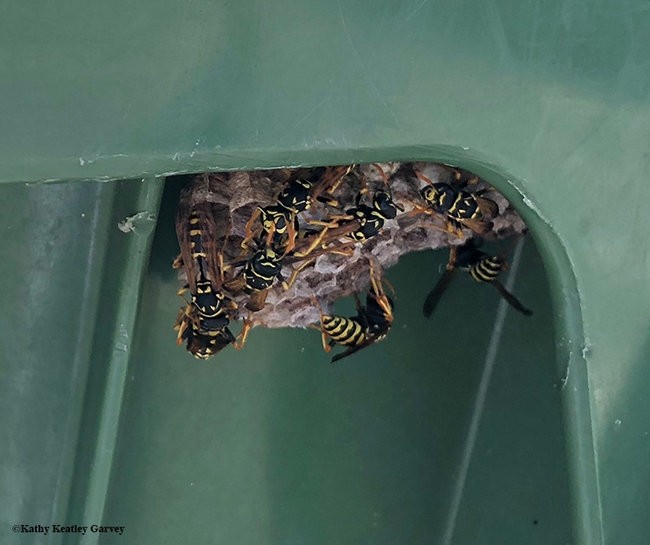
Close-up of the European paper wasps building their nest beneath the overhanging lid of a recycling bin. (Photo by Kathy Keatley Garvey)
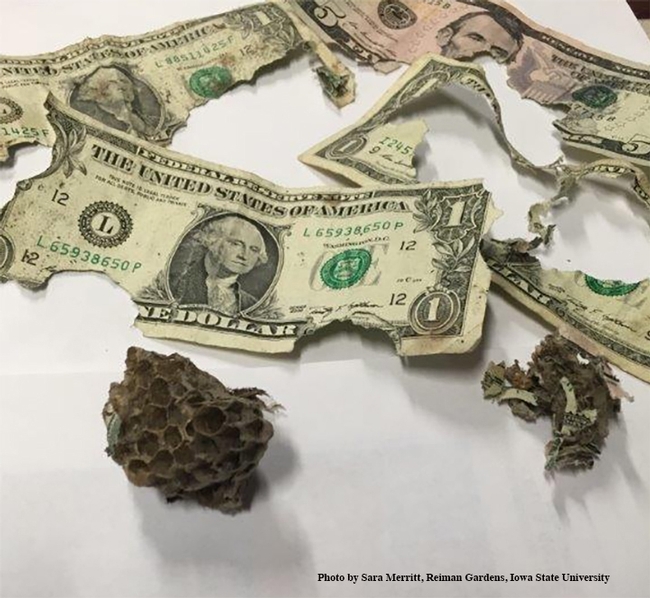
European paper wasps even built a nest in a donation box in the Reiman Gardens, Iowa State University. "These ladies had expensive taste," quipped associate professor Amy Toth, who reseachers European paper wasps. (Photo by Amy Merritt, Reiman Gardens)
Getting Steak and Dessert at the Same Time
Monarch butterflies aren't the only insects that hang around milkweed, their host plant. You're likely to see a variety of predators, such as the European paper wasp, Polistes dominula. This paper wasp is a little skittish around paparazzi so it helps to use a long macro lens, like a 105mm or a...
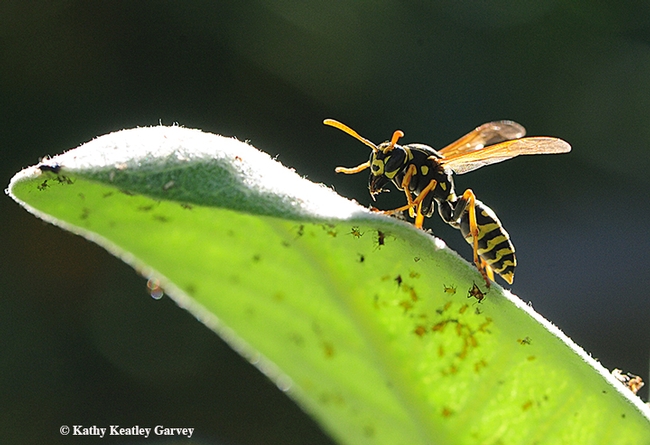
A European paper wasp catching prey on a showy milkweed, Asclepias speciosa. (Photo by Kathy Keatley Garvey)
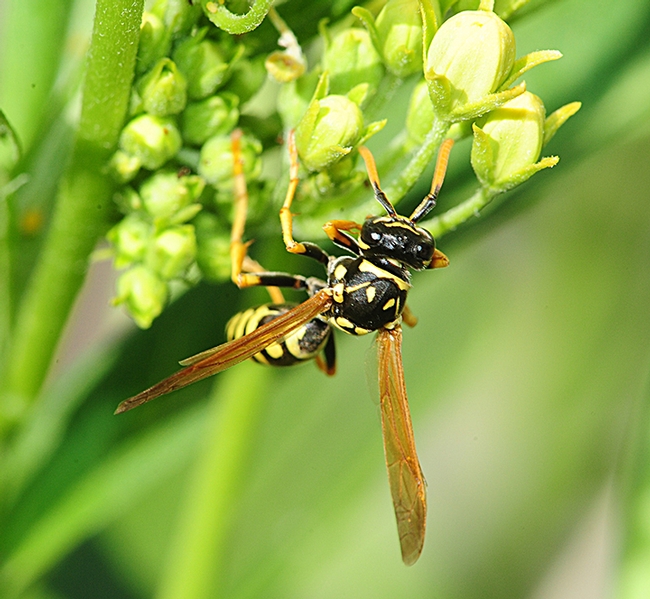
A European wasp feeding on prey on a tropical milkweed, Asclepias curassavica. (Photo by Kathy Keatley Garvey)
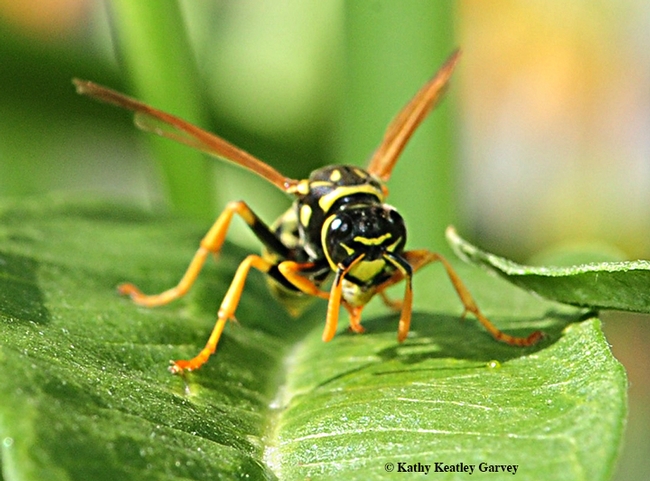
Eye to eye, and nose to antennae with a European paper wasp. (Photo by Kathy Keatley Garvey)
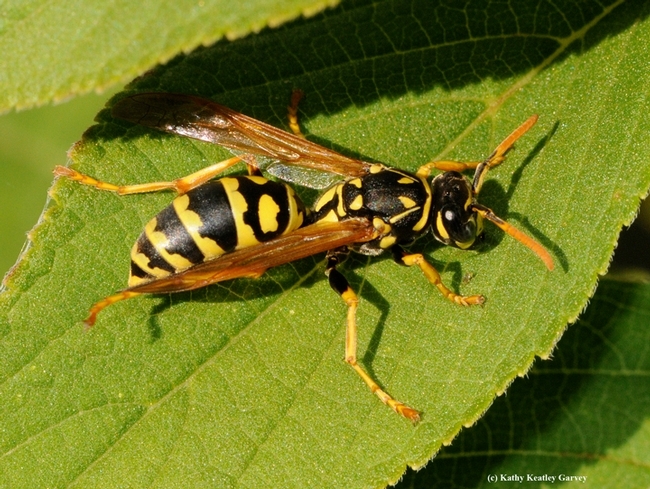
Close-up of European paper wasp. (Photo by Kathy Keatley Garvey)
Of wasps and penny-farthings and holiday gifting

Umm, a t-shirt? Right, you nailed it!
If you're trying to find something "buggy" for your friends and family, then you'll want to take a look at the design that won the UC Davis Entomology Graduate Students' Association (EGSA) t-shirt contest.
"Hymenoptera on a Bike" is the work of Stacey Rice, a junior specialist in the lab of UC Agriculture and Natural Resources Cooperative Extension specialist Larry Godfrey, who is based at UC Davis. Rice researches Bagrada bugs (Bagrada hilaris), an invasive stink bug from Africa known for attacking cole crops, including broccoli, cabbage, collards, Brussels sprouts, cauliflower, kale, and mustard.
She is also an artist, and a very creative one at that. So when the EGSA announced its annual t-shirt contest, Rice decided to fuse art with science.
“I wanted to draw a penny-farthing, which is part of the UC Davis culture,” she said. "Then I wanted an insect that would be able to put its abdomen on the seat and have long enough legs to reach the pedals.”

An alumnus of UC Davis, Rice received her bachelor's degree in biological sciences with a minor in veterinary entomology in March 2015. Her goal is to attend graduate school and receive her doctorate, either in integrated pest management or forensic entomology.
She became interested in both fields after enrolling in a “behavioral ecology of insects” course taught by Edwin Lewis, associate dean for agricultural sciences in the College of Agricultural and Environmental Sciences, and professor and former vice chair, UC Davis Department of Entomology and Nematology.
The t-shirt, now available to the public on the EGSA's website, sold well at the Entomological Society of America's recent meeting in Minneapolis. (For more information on the T-shirt and other EGSA t-shirts available, access the online store at http://mkt.com/UCDavisEntGrad or contact EGSA treasurer Cindy Preto at crpreto@ucdavis.edu. All proceeds benefit EGSA.)
And wasps? Think #wasplove.
When Amy Toth, an assistant professor in the Department of Ecology, Evolution and Organismal Biology, Iowa State University, Ames, presented a seminar in May to the UC Davis Department of Entomology and Nematology, she covered her latest research on wasps and her enthusiasm was contagious.
We later asked her to list why she loves wasps (she coined the hashtag, #wasplove), and she obliged:
- They are pollinators
- They contribute to biocontrol of lepidopteran pests in gardens and on decorative plants
- They have been shown to carry yeasts to winemaking grapes that may be important contributors to the fermentation process and wonderful flavors in wine!
- They are the only known insect (Polistes fuscatus) that can recognize each other as individuals by their faces.
- They are devoted mothers that will dote on their young all day long for weeks, defending their families with fury.
- Their social behavior, in my opinion, is the most human-like of any insect. They know each other as individuals, and are great cooperators overall, but there is an undercurrent of selfishness to their behavior, manifest in nearly constant passive-aggressive interactions between individuals.
- They are artists. They make perfect hexagonal nest cells out of paper, which they make themselves out of tree bark + saliva.
- They are extremely intelligent. They're predators, architects, good navigators, and great learners. Among insects, they have large brains, especially the mushroom bodies (learning/memory and cognition area of insect brain).
- They are beautiful, complex, and fascinating creatures!
And to that list, we add No. 10: wasps are also photogenic!
Especially when they're riding a penny-farthing.
Author: Kathy Keatley Garvey
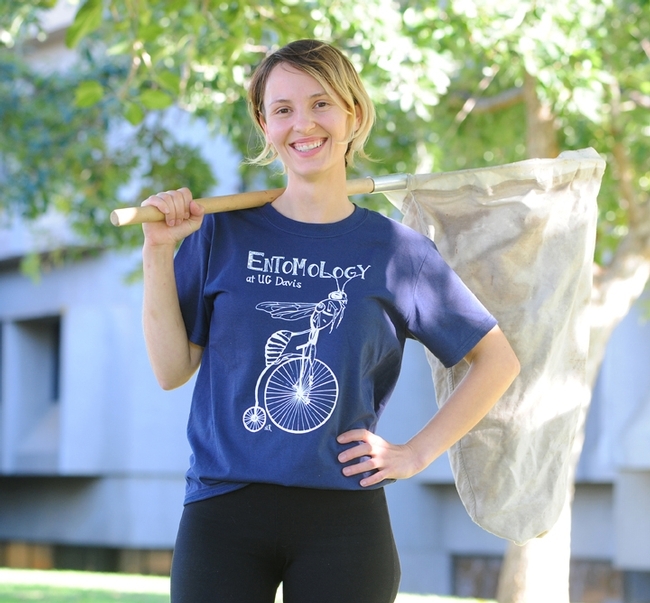
Junior specialist Stacey Rice of the UC Davis Department of Entomology and Nematology wearing the award-winning t-shirt that she designed. (Photo by Kathy Keatley Garvey)

A foraging European paper wasp, Polistes dominula. (Photo by Kathy Keatley Garvey)
